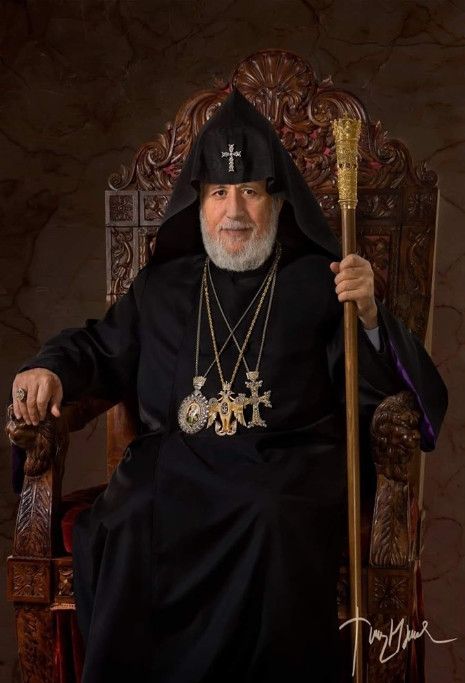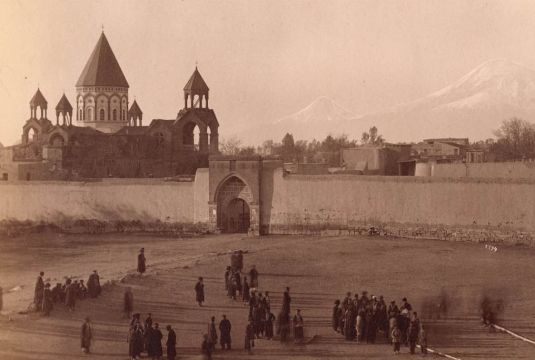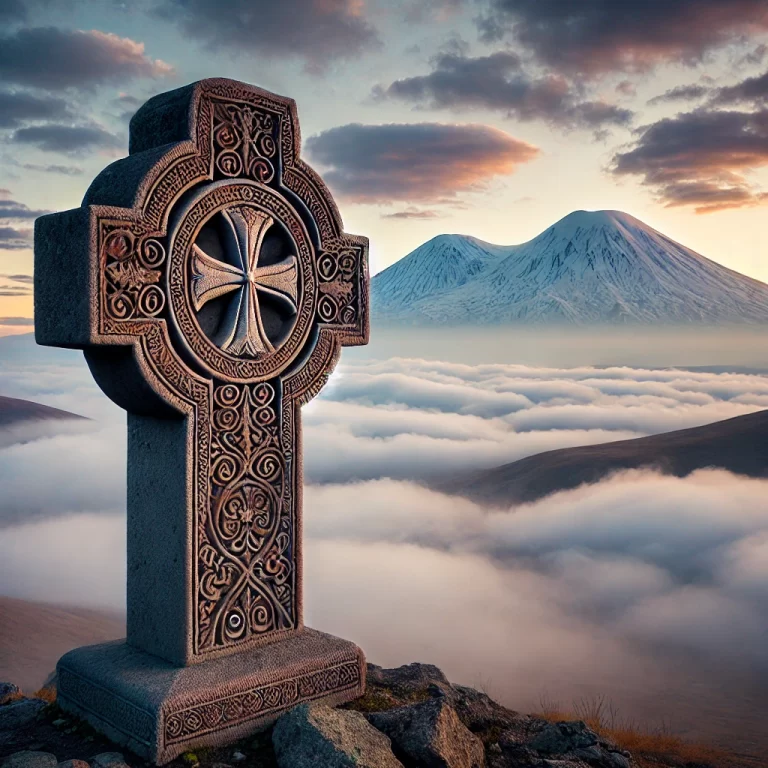Christianity and the Armenian Church have held a central and vital position with respect to all aspects of Armenian life. Christianity in Armenia can be traced back to the age of the Apostles. Two of Christ’s Apostles – Thaddeus and Bartholomew – were the first evangelists of Armenia preaching the Gospel there as early as the second half of the century. In the early fourth century, St. Gregory the Illuminator (c. 240-332) formally established the church in Armenia, when King Tiridates III was baptized and proclaimed Christianity the official religion of Armenia. With the support of the royal family, Christianity was able to spread quickly throughout Armenia and within just a few centuries to permeate all aspects of Armenian life and culture.
St. Gregory’s son, Aristakes, succeeded his father as Catholicos. Aristakes was the representative of the Armenian Church at the Council of Nicaea in 325. The Council of Nicaea, the first ecumenical council, set forth the orthodox Christian doctrine of the Trinity. This doctrine is formulated in the Niceaea Creed which is professed every Sunday during the Divine Liturgy. Under Catholicos Nerses (353-373), monasteries and various charitable institutions were first established throughout Armenia.
The Christianization of Armenia determined the entire future course of Armenian history, as the unique National Church became distinctly identified with the Armenian people and formed the nation’s spiritual and cultural heritage. Christianity gave a powerful boost to the flourishing of a new Armenian culture.
In order to make the Christian faith accessible to the people in a written form, a monk by the name of Mesrob Mashtotz created the Armenian alphabet in 406A.D. Soon thereafter, the Holy Scriptures were translated into Armenian, followed by the biblical, theological and liturgical writings of eminent church fathers. Some of the writings of the Greek and Syrian church fathers have survived only in Armenian versions. This most important era is known as the Golden Age of Armenian History.
Overt expressions of the Church’s activity in Armenia itself were severely hampered during that country’s seventy-year period of Soviet rule; however, since the demise of the USSR, the new independent Republic of Armenia has experienced a vigorous revival of religious spirit and the Church has resumed its traditional public role as the “national faith” of the Armenian people.
CHURCH
The Armenian Church is one of the oldest branches of the Christian faith.
The Faith of the Armenian Church is transmitted through the church’s Holy Tradition. The Bible, liturgy and worship, writings of the church fathers, church councils, saints, canons, religious art and rituals – organically linked together – formulate the Holy Tradition of the Church. This faith is articulated in the Creed of the Armenian Church, which in turn defines the church’s raison-d’etre and sets the parameters of its modus operandi.
The Armenian Church belongs to the Orthodox family of churches, known as the Oriental Orthodox or non Chalcedonian Churches – namely, the Armenian, Coptic, Syrian, Ethiopian and Indian Malabar – churches.
The functional structure of the Armenian Church is primarily based on the canons and established traditions of the Armenian Church, which were formulated over the centuries. One of the most important aspects of the Armenian Church administration is its counciliar system.
The administrative, doctrinal, liturgical and canonical norms of the church are set and approved by a collective and participatory decision making process.
The Chief Bishop and Supreme Head of the Armenian Church is the Catholicos of All Armenians, who resides in Holy Etchmiadzin. A National Ecclesiastical Assembly consisting of lay and clergy representatives of the Armenian churches from around the world elects the Catholicos.
The spiritual leadership of the Catholicos is not confined to Etchmiadzin and Armenia. Over the centuries, as more and more emigration of Armenians occurred, the Holy See had to oversee the spiritual needs of Armenian communities around the world. Thus, Patriarchates and Dioceses were established in areas of large Armenian concentrations in different countries.
There are four hierarchical Sees in the Armenian Church: the Catholicate of All Armenians in Etchmiadzin, the Catholicate of the Great House of Cilicia (established in Lebanon in 1930, but roots go back to the 13th century), the Patriarchate of Jerusalem (established in the early 14th century) and the Patriarchate of Constantinople (established in 1461).
HIS HOLINESS GAREGIN II
Supreme Patriarch and Catholicos of All Armenians

His Holiness Garegin II, Catholicos of All Armenians (Photo: Official website of the Holy Echmiadzin)
His Holiness Garegin II was born in 1951 in the village of Voskehat, near Echmiadzin. He graduated from the seminary of Holy Echmiadzin with honors in 1971. He was ordained a deacon in 1970 and a monk in 1972, at which time he received the priestly name “Karekin”.
Shortly thereafter, His Holiness Vasken I (Catholicos of All Armenians, 1956-1994) sent the new priest to Vienna to study theology. In 197S, Fr. Nersissian moved to Germany, where he graduated from Bonn University while serving as pastor to the local Armenian community. Following a brief return to Armenia, he enrolled in postgraduate studies at the Russian Orthodox Academy in Zagorsk, Russia, from which he graduated in 1979.
Appointed head of Araratian Pontifical diocese in June 1983, he was elevated to the rank of bishop on October 23 of that year by the hand of His Holiness Vasken I. Catholicos Vazgen granted him the title of “archbishop” in November 1992. Following the death of Catholicos Vazgen I, Archbishop Nersissian was a candidate for the pontifical throne during the National Ecclesiastical Assembly of April 1995, but conceded victory to His Holiness Karekin Sarkissian, who thereafter became Catholicos Garegin I (Catholicos of All Armenians, 1995-1999]. The latter, being treated for cancer in New York, appointed Archbishop Nersissian as the Vicar General of Holy Echmiadzin in November 1998, in which capacity Nersissian served until the late Catholicos’ death in June 1999.
In late October 1999, the Armenian Church chose a successor to the deceased Garegin I. Armenian Church communities around the world sent delegations of lay and clerical leaders to Armenia, to deliberate and elect a new Catholicos, the 132nd in a continuous line dating back to the 4th century. On October 27,1999, Archbishop Nersissian was elected, and following his consecration and enthronement on November 4, he took the name and title of His Holiness Karekin II, Supreme Patriarch and Catholicos of All Armenians.
In this capacity, Catholicos Garegin II presides over the Supreme Spiritual Council (the Armenian Church’s governing college of bishops), and is the chief shepherd of the world’s 7 million Armenian Apostolic Christians.
HOLY ECHMIADZIN
The Seat of the Catholicos of All Armenians

Holy Echmiadzin (Photo: Official website of the Holy Echmiadzin)
Holy Echmiadzin is a primary spiritual seat of authority for the 10 million Armenian Christians living in Armenia and in Diaspora communities around the globe. According to the 5th century Armenian historian Agathangelos, soon after the declaration of Christianity in Armenia, St. Gregory the Illuminator had a vision of Christ descending in a flood of light and pointing to the site where the first Armenian church was established. The church was completed in 303 A.D. and soon became the residence of the first Armenian Catholicos, St. Gregory the Illuminator. It gradually grew into a center of education and the arts, attracting a large number of population to Vagharshabad.
According to the 5th century Armenian historian Agathangelos, soon after the declaration of Christianity in Armenia, St. Gregory the Illuminator had a vision of Christ descending in a flood of light and pointing to the site where the first Armenian church was established. The church was completed in 303 A.D. and soon became the residence of the first Armenian Catholicos, St. Gregory the Illuminator. It gradually grew into a center of education and the arts, attracting a large number of population to Vagharshabad.
Repeated invasions caused extensive destruction and looting of Holy Etchmiadzin, which was always rebuilt and revived as soon as peace prevailed. There have been long periods when the Seat of the Catholicos had to be transported to safer regions.
Since 1441, the Holy See of Etchmiadzin has once again become the center of the Armenian Church.
Source: Archive of Ministry Of Foreign Affairs of Republic of Armenia


